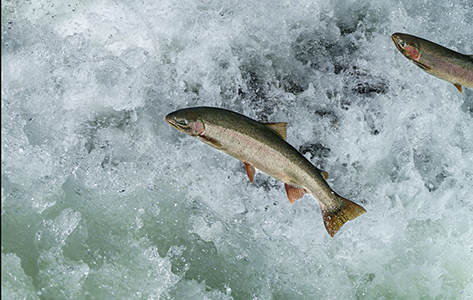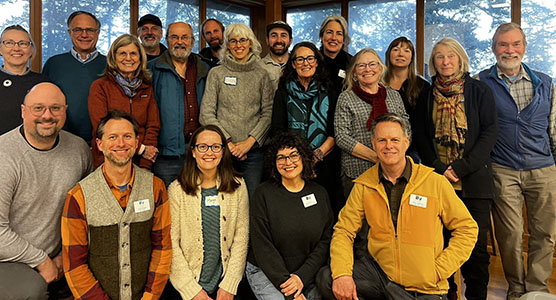A 20-member scientific panel warns that increases in global carbon dioxide emissions are acidifying waters of the North American West Coast at an accelerating rate; severe ecological consequences are anticipated.
— from Martha Kongsgaard, Marine Resources Advisory Council —
Global carbon dioxide emissions are triggering troubling changes to ocean chemistry along the West Coast that require immediate, decisive actions to combat through a coordinated regional approach, a panel of scientific experts has unanimously concluded.
A failure to adequately respond to this fundamental change in seawater chemistry, known as ocean acidification, is anticipated to have devastating ecological consequences for the West Coast in the decades to come, the 20-member West Coast Ocean Acidification and Hypoxia (OAH) Science Panel, which included scientists from the University of Washington and NOAA’s Seattle office, warned in a comprehensive report unveiled Monday, April 4.
“The findings of the West Coast OAH Science Panel build on those of the Washington Blue Ribbon Panel on Ocean Acidification, extending those findings to the entire West Coast, and incorporating consideration of the growing stressor, hypoxia. The strength of the OAH Panel’s findings lies in the coordinated, regional approach to the problem and opportunities for mitigation and adaptation that are scaled to the West Coast,” said Dr. Terrie Klinger, who participated in both panels and co-directs the Washington Ocean Acidification Center.
“Due to the combined impacts of ocean acidification and seasonal upwelling, the West Coast is exposed to unusually high volumes of seawater at elevated acidity levels,” explained Dr. Richard Feely of NOAA’s Pacific Marine Environmental Laboratory in Seattle. Already, marine shelled organisms in Washington are having difficulty forming their protective outer shells, and the local shellfish industry is seeing high mortality rates in early life stages of some commercially-important shellfish species when shell formation is critical. “The acidity of West Coast waters is anticipated to continue to accelerate in lockstep with rising atmospheric carbon dioxide emissions,” said Feely.
The OAH Panel’s final report, titled “The West Coast Ocean Acidification and Hypoxia Science Panel Major Findings, Recommendations and Actions,” summarizes the state of the science around the anticipated impacts of these multiple stressors on our marine resources and outlines a series of potential management actions that the governments of the states of Washington, Oregon, and California, and the province of British Columbia, can immediately begin implementing to offset and mitigate the economic and ecological impacts of ocean acidification.
The Panel is urging ocean management and natural resource agencies to develop highly coordinated, comprehensive multi-agency solutions, including:
- Reducing carbon emissions is critical to addressing the root cause.
- Exploring approaches that involve the use of seagrass to remove carbon dioxide from seawater.
- Supporting wholesale revisions to water-quality criteria that are used as benchmarks for improving water quality, as existing water-quality criteria were not written to protect marine organisms from the damaging effects of ocean acidification.
- Identifying strategies for reducing the amounts of land-based pollution entering coastal waters, especially in bays, estuaries, and sounds, as this pollution can exacerbate the intensity of acidification in some locations.
- Enhancing a West Coast-wide monitoring network that provides information toward development of coastal ecosystem management plans.
- Supporting approaches that enhance the adaptive capacity of marine organisms to cope with ocean acidification.
The report emphasized that global carbon emissions are the dominant cause of ocean acidification and that the West Coast states should advance regional carbon management strategies. The Panel deliberately focused its recommendations around actions West Coast ocean management and natural resource agencies can take in each jurisdiction to combat the challenge at the regional level. For example, the Washington Marine Resources Advisory Council (MRAC) – formed after the Blue Ribbon Panel on Ocean Acidification – is advancing the Blue Ribbon Panel’s ocean acidification strategies, helping Washington adapt and respond to ocean acidification. Its members plan to go to the state legislature in 2017 for more funding for research, monitoring, modeling and outreach.
“The Panel’s findings build powerfully on the pioneering work underway in the state of Washington. Our Marine Resources Advisory Council, including individuals representing the shellfish, commercial and recreational fishing industries, serves as a regional model,” said Martha Kongsgaard, Chair of MRAC and PCC Ocean Acidification Subgroup representative. “The scientific collaboration across states and into Canada is surely the way of the future as we grapple with the urgent challenges we face as changing ocean conditions impact our valuable marine resources.”
Many of the science actions noted by the Panel are consistent with science needs recommended by Washington’s Blue Ribbon Panel, a subset of which are currently being funded by the Washington legislature and implemented via the Washington Ocean Acidification Center, often in collaboration with federal partners NOAA and EPA and the U.S. IOOS regional association, NANOOS. “The Washington OA Center plays a role in coordinating science and monitoring, in collaboration with many partners, and then consistently communicating results to the MRAC, providing a critical link to policy makers and the legislature in Washington state. We find this structure to be an effective means of connecting science with policy and recommend that this type of coordination could be implemented along the West Coast,” said Dr. Jan Newton, who co-directs the Washington Ocean Acidification Center and who participated in both panels.
West Coast policymakers will use the Panel’s recommendations to continue to advance management actions aimed at combatting ocean acidification and hypoxia. This work will be coordinated through the Pacific Coast Collaborative (PCC), a coalition of the offices of the governors of Washington, Oregon, California, and the premier of British Columbia, which have been working together on West Coast ocean acidification since 2013. The PCC has been engaging state and federal agencies across multiple jurisdictions to elevate the need for action along the West Coast.
“Our communities are seeing these changing ocean conditions firsthand. Equipped with the latest science from the West Coast OAH Science Panel, we must act together as a region to monitor these changes and take strong actions to slow the impacts and adapt where we’re already seeing changes occurring,” said Julie Horowitz, Governor Jay Inslee’s shellfish policy advisor and PCC Ocean Acidification Subgroup representative. “We have a strong collaboration up and down the coast and we have the partnerships to lead on this together.”
The West Coast OAH Science Panel, which was convened for a three-year period that ended in February 2016, also has recommended the formation of a West Coast Science Task Force to continue to advance the scientific foundation for comprehensive, managerially relevant solutions to West Coast ocean acidification.
“Ocean acidification is a direct threat to the nation’s $2.8 billion dollar shellfish industry, and the jobs that depend on it, said U.S. Senator Maria Cantwell (D-WA). “Yet we don’t know the full effects of ocean acidification on other marine industries. I applaud the panel’s work to develop a plan to address ocean acidification across ecosystems on the West Coast. We need additional monitoring, research and adaptation science to help shellfish growers, scientists and coastal communities. I am fighting to bring additional research and monitoring funding back to the West Coast, and I look forward to working with the panel to combat ocean acidification.”
*************
History of the Panel
In September 2012, the California Ocean Protection Council (OPC), a state agency charged with protecting California’s ocean and coastal ecosystems, requested that the nonprofit California Ocean Science Trust (OST) convene a science advisory panel to recommend a long-term management strategy for combatting the effects of ocean acidification and hypoxia. The State of California then joined forces with the States of Oregon and Washington and the Province of British Columbia to broaden the Panel’s focus to include the entire North American West Coast, a region that is particularly vulnerable to ocean acidification. As a result, Panel membership was expanded to reflect the depth of expertise from across the region, and surveys were conducted at the state, regional, and federal levels to understand decision-makers’ science needs. These surveys, building off of the work of the Washington State Blue Ribbon Panel on Ocean Acidification, formed the foundation for the work of what then became the West Coast Ocean Acidification and Hypoxia Science Panel. Over a three-year period, the 20-member Panel examined the full range of impacts related to changing ocean chemistry, going beyond ocean acidification and hypoxia to include related stressors and impacts. The Panel’s final report, ““The West Coast Ocean Acidification and Hypoxia Science Panel Major Findings, Recommendations and Actions,” is supported by a series of lengthier Panel technical guidance documents aimed at providing more detailed information for water-quality and natural resource managers and their scientific staffs. For more information about the Panel, go to westcoastoah.org.
**If you are reading theOrcasonian for free, thank your fellow islanders. If you would like to support theOrcasonian CLICK HERE to set your modestly-priced, voluntary subscription. Otherwise, no worries; we’re happy to share with you.**







